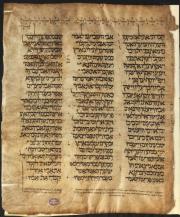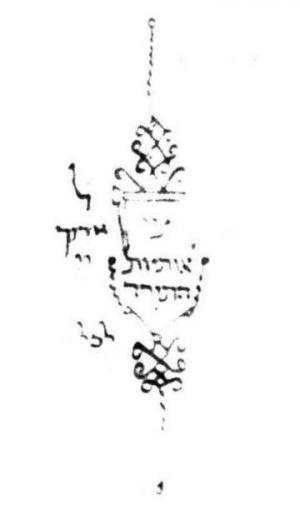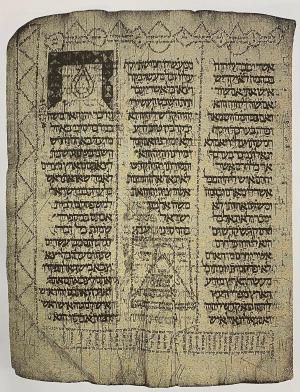Obj. ID: 53341
Hebrew Illuminated Manuscripts Lailashi Codex, Oriental, 11th century (?)

The description is based on: Gomelauri, Thea (with a contribution by Joseph Ginsberg), The Lailashi Codex: The Crown of Georgian Jewry, Treasures of the Taylorian: Cultural Memory, vol. 6, (Oxford: Taylor Institution Library, 2023)
sub-set tree:
Text space: 305 × 285 mm, average dimensions of the column of the first quire are 290 × 71 mm, while the rest of the codex is written varies between 300 × 270 and 285 × 280 mm.
Pentateuch with massorah magna and parva vocalized and punctuated. It is in the Vavei Ha'amudim layout
Genesis (fols. 1- 42v); missing text at the beginning of the book (Gen. 1:1- 3:24a) and the manuscript starts with Gen. 3:24b; there are some more text that is now missing: Gen. 20:9b–21:23a (missing between 12v to 13); Gen. 31:49b–32:24a (missing between fols. 24v to 25); Gen. 49:13b–50:26 (missing between fols. 42v to 43; this missing text is now at the NLI, Ms. Heb. 4°5941).
Exodus (fols. 43v-78); missing text in some places: Exodus 2:14b–3:16a (missing between fols.. 43v to 44), Exodus 9:33a–10:24a (missing between fols. 49v-50), Exodus 19:9b–21:31a (missing between fols. 58v-59).
Leviticus ( fols. 78- 103); missing some text of this book as follows: Lev. 5:24b–7:11 (missing between fols. 81v-82); Lev. 8:36b–10:7a, (missing between fols. 83v-84).
Numbers (fols. 103- 140), no text is missing.
Deuteronomy (fols. 140- 169v) ending with Deut. 32:9. Deut. 32:10–33:10a is missing and now at the NLI Ms. Heb. 4°5941 and the rest, Deut. 33:10b–34:12 is missing.
(based on Thea Gomelauri, The Lailashi Codex, pp. 160- 171).
169 leaves (At present, there are only 172 leaves of the manuscript extant, including 3 leaves located in the NLI in Jerusalem; The manuscript originally consisted of 188 leaves)
Crude and thick parchment (Q: Is it easy to distinguish between the hair and flesh sides of the parchment?, color of flesh and hair sides?)
fly leaves?
Ink: The biblical text is written with dark ink, vowel points in ink of a lighter color.
Columns:3 columns per page. The main text is written in three columns, except for the Song of the Sea and Song of Moses which are written in different styles designated for special poetic passages.
None.
- One illustrative Masorah finalis at the end of Leviticus (fol. 103) presents elaborated micrography over seven lines at the lower part of the middle column. It displays a large triangle which looks like a mountain with a large tear droplet over it. Rachel Milstein suggests God presence over Mount Sinai.
- Twenty-three pages include the masorah in micrographyin various shapes. Eighteen pages are in Tbilisi, Georgia, and five in the NLI, Jerusalem, Israel. The micrographic designs appear on the following folios: 1r–1v; 2r–2v; 3r, 43r–43v, 54v–55r (First Song of Moses), 77v–78r, 102v–103r, 139v–140r, 145v–146r, 169v, and five more pages in the NLI (fols.1v-3v). They form various shapes, such as tear droplet shapes (fols. 1v–2, 26 and 169v), semi-circles, circles, zigzags with circles, triangles, and various other shapes. The five consecutive pages of Genesis (fols. 1r, 1v, 2r, 2v, and 3r), the end of Genesis features a rectangular filled with micrographic masorah occupies sixteen lines of the third column (NLI, fol. 1v). The First Song of Moses written on folios 54v–55r is adorned with special patterns of micrography which have no parallel anywhere in the manuscript. The final two pages of Exodus depict a complex micrographic design. The forty semicircles in the top and bottom margins on folios 77v–78r enclose double triangles, triangles, circles, and house-shaped patterns. Leviticus starts on the same page where Exodus ends, and the micrographic design of these books is beautifully correlated.
- Masoretic Signs:
- Sign of half of the Pentateuch in letters, words and verses: Half of the Pentateuch in verses, Sign (fol. 83(, next to Lev. 8:7, according to the Masoretic notes, it also is the exact centre of the Lailashi Codex, the original folio number 94. However, according to the Talmudic tradition the half Pentateuch is in verses Lev. 13:33, on folio 87r in the Lailashi Codex, but it is not marked; Half of the Pentateuch in words, Sign (fol. 84), next to Lev. 10:16 according to the Talmudic tradition; Half of the Pentateuch in letters, Sign (fol. 85v), next to Lev. 11:42, according to the Talmudic tradition.
- Half-book signs of the five books of the Pentateuch: The Half-book sign of Genesis (fol. 20r), next to the verse of Gen. 27:40, Half-book sign of Exodus (fol. 59v), next to ??? (now is faded), Half-book sign of Leviticus (fol. 89v) next to the verse of Lev. 15:7, and Half-book sign of Deuteronomy (fol. 156v) next to Deut. 17:9. There is no Half-book sign for the book of Numbers. The midpoint of the Book of Leviticus on fol. 89v could be easily mistaken for a sign of a parashat Acharei Mot (fol. 90v).
- Parash Signs: simply written with three Hebrew letters: phe – resh – shin ( פרשthe first three letters of the word parashah).
- Sum of verses in gematria: Ten Sum of verses at the end of ten parshiyut (out of thr 54 parshiyut). It appears e.g. at the end of the parashat Miketz (fol. 37r), at the end of Vayigash (fol. 40v) which is marked with a drawing of a two-line shape above the word Hashem. This sign matches the parashah marker placed on the opposite side of the column in the same line.
4. A schematic drawing of a gate or a section of the tent, with what seems to be a lamp hanging from the ceiling which marks the opening of the Book of Numbers (fol. 103). The book ends with the same schematic drawing encircling the Masorah finalis
Unknown time:
- Inscription 1 (fol. 95): The inscription reads:
'סימן מכותאיס תהלה לאל כבר הבנתי לפי קוטן דעתי מרמזי הספר הקדוש'
"‘Syman from Kutais, Praise God, I have already understood, with my little knowledge, the implications of this Holy Book’".
This note contains a crucial reference to the largest Jewish settlement in West Georgia. The line does not record any kind of transaction or change of ownership of the manuscript, but it suggests that at some point in history, some work might have been done on the manuscript in Kutaisi.(copied from Gomelauri 2023, pp. 137- 138).
- Inscription 2, folio 95r
The second vertical inscription is written below the first one in large letters, exceeding the script of the manuscript. The writing begins below the last line of the consonantal text, under the lower margin of the Masorah Magna, and extends in an upward direction, ending before the second line of the first column. This line quotes Job’s response to Bildad’s accusations (Job 19:27) and ends with a punctuation sign signifying the end of the verse:
אשר אני אחזה לי ועיני ראו ולא זר כלו כליתי בחקי:
'I myself, not another, would behold Him; Would see with my own eyes: My heart pines within me'.
- Inscription 3, folio 76v
Fol. 76v contains the text of Exodus 39:17–32. It is one of the six leaves that were in the care of Chacham Moshe Khakhiashvili.
Unlike the two inscriptions mentioned before, the direction of the script on this fragment starts from the upper margin of the leaf and extends toward the lower margin. Unfortunately, this fragment is not fully legible. However, it clearly spells the Tetragrammaton, which suggests that it could be a citation of a biblical verse, as in the case of fol. 95r, but without further research, it is impossible to ascertain any claim. The fragment reads:
... מד יקוק (Tetragrammaton) אלמ...
(copied from Gomelauri 2023, p. 139).
1869, Elul
The first historical record of the Lailashi Codex was made by Joseph Judah Chorny (1835–1880), Jewish ethnographer from Minsk who mentions the Codex in his Diary of Caucasian and Trans-Caucasian Journey, in his report on the visit to the Lailashi Village (Gomelauri 2023, pp.16-18).
1938 - 1939:
Confiscation of the Lailashi Codex. It was taken from the Jewish Community in Lailashi into the Jewish Historic-Ethnographic Museum in Tbilisi, that was established about 5 years earlier on Nov. 1933 (Gomelauri 2023, pp. 25, 27).
During that time, It seems that Chacham Moshe Khakhiashvili who served as Rabbi of the Lailashi community at the time of the manuscript’s removal by the Communist regime, removed from the Codex six folios. When he moved to Oni, he took them with himsef. It is told that he got ill soon after handing the six leaves over to the Institute of Manuscripts. Weil indicated (without citing any source) that Chacham Moshe’s death was allegedly linked to his ‘abandoning sacred leaves in profane hands.’ Chacham Moshe got ill and a few months later he died in 1967. Following Tsereteli’s 1968 announcement regarding ‘finding six new leaves very recently’, one can safely assume that the new leaves arrived in the Institute of Manuscripts either in 1967, 1966 or, at the earliest, 1965, after which Tsereteli himself may have foliated the entire volume.[1] However, these six leaves are already in their places a few years before Chacham Moshe's illness and death as evident by the microfilm of the Lailashi Codex from 1960. This microfilm was brought by the Georgian delegation who, during their expedition in search of Rustaveli’s fresco in Jerusalem, in the autumn of 1960, presented a microfilm of the manuscript to the Israeli President Yitzhak Ben-Zvi, which was then given to the Ben Zvi Institute and was then given to the Ben Zvi Institute, and can be seen in NLI’s ‘Ktiv’ project since 2019.[2]
1941: The Lailashi Codex was put on display in the historical section of the anti-religious exhibition (Gomelauri 2023, p. 34), after a while on the same year, the Jewish Historic-Ethnographic Museum in Tbilisi was liquidated. The museum’s building, including the exhibition hall with its artefacts, was given to the cotton factory for storing cotton.
1951?- : The Lailashi Codex, together with the collections of the Jewish museum, was given to the State Museum of History of Georgia. (Gomelauri 2023, p. 38).
1958: the Soviet government formed the Institute of Manuscripts on the grounds of the Manuscript Department of the State Museum of History, and the Lailashi Codex changed formal owners. Over the years, the Institute of Manuscripts went through several institutional reorganizations.
1965?-1968: Tsereteli wrote that new leaves had surfaced ‘very recently’in Oni, a large Jewish settlement near the Lailashi village. Tsotne Kikvidze, an employee of the Institute of Manuscripts, brought folios 43, 63, 64, 67, 77, and 78 to Tbilisi, and inserted them into the codex.[3]
2006: The Laialshi Codex emerged as the National Centre of Manuscripts (NCM) which inherited the collections plundered by the Soviet regime after the liquidation of the Jewish Historical-Ethnographic Museum.
Gomelauri, Thea (with a contribution by Joseph Ginsberg), The Lailashi Codex: The Crown of Georgian Jewry, Treasures of the Taylorian: Cultural Memory, vol. 6, (Oxford: Taylor Institution Library, 2023)
Milstein, Rachel, "Multicultural Symbolic Language in the Earliest Illustrations of the Hebrew Bible," in Ha-islam ve-olamot ha-shazurim bo [Intertwined Worlds of Islam. Essays in Memory of Hava Lazarus-Yafeh] (Jerusalem: The Hebrew University of Jerusalem, 2002), 393- 442. (in Hebrew)
Chorny, Joseph Judah. Sefer Ha-masaʻot Be-erets Ḳaṿḳaz Uva-medinot Asher Me-ʻever Le-Ḳaṿḳaz U-ketsat Medinot Aḥerot Be-negev Rusya Mi-shenat 5627 ʻad Shenat 5635. [Book of travels in the land of Caucasus and Transcaucasia and a few other countries in Southern Russia from the year 5627 to the year 5635] St Peterburg: Ha Hevrah “le-harbot Haskalah etsel Yehude Rusya”, 1884.
In February 1968, an English-language tabloid, the Soviet Weekly, informing the world ‘Russians Find in Georgia of Tenth Century Pentateuch Manuscript.’ The language of announcement suggests that it must have been written by Tsereteli. Georgi Tsereteli (1904–1973), himself, the founding father of Oriental studies in Georgia.[1]
February 27, 1968: The Jewish Telegraphic Agency (JTA) in New York, re-published an extract in its Daily News Bulletin, no. 39
Tsereteli, Giorgi. ‘The Tbilisi Hebrew Manuscript of Moses’ Pentateuch.’ Oriental Philology 3 (Tbilisi: Mecniereba, 1969).
Soltes, Ori Z. National Treasures of Georgia. London: Philip Wilson, 1999, Cat. 112 (Gomelauri 2023, p. 57) or Cat.121 (Gomelauri 2023, p. 61).
Facsimile copy of the Lailashi Codex, 2009. Introductions by Ilia II, Buba Kudava, and Zaza Aleksidze.
Weil, G.E. & A. M. Gueny, ‘Le manuscrit du Pentateuque de Tbilissi. Aspects paleographique codicologique et massoretique.’ Philologia Orientalis 4 (1976), 178–209.
Thea Gomelauri, "The Best Kept Secret of Georgian Jewry", JewThink, 1 December 2020.
https://www.jewthink.org/2020/12/01/introducing-the-best-kept-secret-of-georgian-jewry-the-lailashi-codex.
Ofer, Yosef," מקורו של מנהג בי"ה שמ"ו בכתיבת ספרי תורה" , JSIJ 22 (2022), 1–17.
[1] Gomelauri writes: 'The edition of the Soviet Weekly which carried the above-mentioned report appears to have vanished from the face of the earth. A thorough search through the Bodleian Libraries, the British Museum, and the United Nations Archives, which hold all the copies of the Soviet Weekly, could not locate it' (Gomelauri 2023, p. 49).















